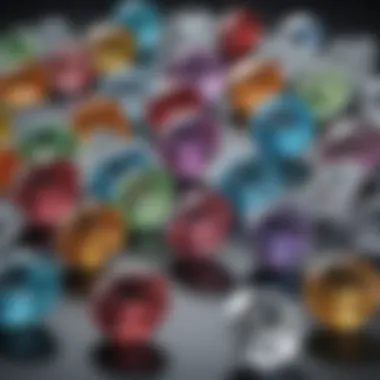Understanding the Expertise of Diamontologists


Intro
Diamontologists play a critical role in the gemstone industry, primarily focusing on diamonds. They possess specialized knowledge that allows them to assess, evaluate, and authenticate these precious stones. Understanding the expertise of a diamontologist enhances the appreciation of diamonds among enthusiasts, collectors, and industry professionals. This article will delve into the responsibilities, qualifications, and tools of diamontologists while examining their contribution to ethical sourcing and the educational aspect of their role.
Gemstone Overview
Definition and Characteristics
Gemstones are natural mineral crystals or organic materials that are cut, polished, and used in jewelry and decoration. Diamonds, specifically, are renowned for their unmatched brilliance and hardness. Formed deep within the Earth under high pressure and temperature, diamonds consist primarily of carbon atoms arranged in a crystal lattice. Their unique composition gives rise to properties such as superior light refraction and exceptional durability.
Classification of Gemstones
Gemstones are classified based on various criteria, including their mineral structure, color, and rarity. Common classifications encompass:
- Precious Gemstones: These include diamonds, rubies, sapphires, and emeralds. They are highly valued for their beauty, rarity, and durability.
- Semi-Precious Gemstones: This category includes stones like amethyst, aquamarine, and garnet. They are less rare and often more affordable than precious gemstones.
A diamontologist specializes primarily in diamonds, understanding their unique qualities and market valuation.
Properties of Gemstones
Physical Properties
Diamonds have several physical properties that contribute to their allure:
- Hardness: Measuring a 10 on the Mohs scale, diamonds are the hardest known natural material.
- Brilliance and Fire: Their ability to refract light results in a sparkling appearance, enhancing their desirability.
Chemical Properties
The chemical composition of diamonds consists entirely of carbon atoms. This simple structure belies the complex interactions that lead to their physical beauty. The presence of trace elements can also affect a diamond's color and overall value. For example, boron impurities can create blue diamonds, while nitrogen can lead to yellow hues.
"Diamonds are not just stones; they are a fusion of nature's artistry and science's precision. Understanding their fundamental properties allows diamontologists to assess their value accurately."
Understanding the Profession of Diamontologist
The role of a diamontologist is crucial in the realm of gemstones, particularly diamonds. This profession not only encompasses the assessment and evaluation of these precious stones but also extends to understanding market trends and ethical sourcing practices. A diamontologist's expertise informs consumers and collectors about the quality and value of diamonds, shaping purchasing decisions and influencing market dynamics.
With a deep knowledge of diamond characteristics and an ability to recognize intricate details, diamontologists serve multiple segments of the industry, from jewelers to private collectors. Understanding this profession helps both enthusiasts and professionals appreciate the science behind diamond valuation and the ethical implications tied to gemstone sourcing.
Definition and Scope of Work
A diamontologist specializes in evaluating diamonds. Their expertise lies in the criteria that determine a diamond's value and quality, including cut, color, clarity, and carat weight. This evaluation process is complex and requires a thorough understanding of gemological principles.
Diamontologists often engage in a variety of tasks, such as:
- Analyzing diamonds: Utilizing tools like microscopes and loupes, they assess each stone's characteristics.
- Appraising value: They provide accurate valuations, crucial for buyers and sellers alike.
- Educating consumers: By sharing knowledge, they help clients make informed decisions when purchasing diamonds.
- Advising on ethical sourcing: They bring awareness to the importance of conflict-free diamonds, ensuring that consumers consider ethical implications in their choices.
The scope of a diamontologist's work extends to both local businesses and global markets, making their role indispensable across the industry.
Historical Context
The profession of diamontologist has evolved significantly over time. Its roots can be traced back to the early days of diamond trading, where minimal knowledge about gemstones prevailed. In those times, merchants relied heavily on intuition and personal experience rather than standardized methods.
The establishment of gemology as a science in the late 19th to early 20th century marked a turning point. Systematic classification and evaluation emerged, leading to the formation of educational institutions like the Gemological Institute of America (GIA). These developments paved the way for the modern diamontologist, who utilizes a combination of science and art in their assessments.
Today, the historical context serves to highlight the ongoing importance of a diamontologist in ensuring quality and ethical standards in diamond transactions. Their expertise, grounded in years of study and practice, remains essential as the market continues to evolve.


Essential Qualifications for Diamontologists
The field of diamontology necessitates a combination of specialized knowledge and practical skills. For those looking to pursue a career as a diamontologist, completing rigorous qualifications is crucial. The expertise gained from education and certifications ensures the professional can accurately assess diamond quality and provide sound advice to clients. Furthermore, being well-qualified can enhance credibility within the gemstone and jewelry industries, potentially leading to increased opportunities and career advancement.
Educational Background
A solid educational foundation is fundamental for a diamontologist. While there is no universal degree requirement, many professionals hold degrees in fields such as geology, gemology, or jewelry design. Programs in gemology specifically expose students to the nuances of diamond characteristics and evaluation techniques. Completing coursework that focuses on materials science and mineralogy can give future diamontologists insights into the composition and properties of diamonds.
Additionally, institutions such as the Gemological Institute of America (GIA) offer specialized diamond training programs. These programs cover critical topics such as the four Cs: cut, color, clarity, and carat weight. Acquiring such knowledge is essential to become competent in gemstone assessment.
Students might also benefit from internships or work placements within the jewelry sector. Hands-on experience is invaluable for understanding market practices and customer expectations.
Certifications and Training
Once the educational background is established, obtaining certifications can further demonstrate a diamontologist's proficiency. Several organizations provide certification programs that validate a professional's expertise in gemology. Achievements such as a Graduate Gemologist (GG) designation from the GIA are highly regarded in the industry.
Training programs often include in-depth study of not just diamonds but also other gemstones. This broadens a diamontologist’s understanding and ability. Familiarity with various analysis methods is also key.
For instance, training in the use of advanced tools such as spectrometers and loupes assists in accurately evaluating diamonds. Knowledge of software tools that analyze light performance can also be an asset in modern gem valuation.
In summary, essential qualifications for diamontologists combine both formal education and targeted certifications. This integrated approach ensures they are well-equipped to navigate the complexities of diamond evaluation and to uphold ethical standards in their practice.
To establish oneself as a reputable diamontologist, a blend of education and accredited certifications is imperative. This not only enriches knowledge but also boosts professional credibility.
The Process of Diamond Evaluation
The process of diamond evaluation is crucial in understanding the value and quality of diamonds. This evaluation involves a systematic approach, assessing various aspects of the diamond to determine its worth in the market. A diamontologist's expertise comes into play here, employing precise methods and advanced technologies. By focusing on specific elements, such as cut, color, clarity, and carat weight, professionals can deliver an accurate valuation and help consumers make informed choices.
Assessment Criteria
Cut
The cut of a diamond significantly affects its brilliance and overall appeal. A well-executed cut maximizes a diamond's reflection and refraction of light, making it appear more vibrant. The proportions, symmetry, and polish are key characteristics of cut quality. Diamonds with excellent cuts are popular due to their visual impact, which is vital for buyers seeking beauty.
One notable feature of the cut is how it impacts the stone's light performance. An ideally cut diamond will exhibit a balanced play of light and shadow, enhancing its overall aesthetic. Poorly cut diamonds can appear dull, losing their desirability. Hence, the cut is vital in establishing not just quality but also market value.
Color
Color grading in diamonds refers to the absence of color, with completely colorless diamonds considered the most valuable. The grading scale ranges from D (colorless) to Z (light yellow or brown). The key characteristic of diamond color is its effect on beauty and perceived quality. Colorless diamonds are preferred in the market, as they exhibit a certain radiance that colored stones cannot replicate.
The unique feature of color grading is that even slight differences can significantly alter a diamond's value. For example, a diamond graded G may look similar to one graded F, but the latter is more valuable. Understanding color is crucial for diamontologists aiming to provide accurate evaluations and help consumers select quality stones that meet their preferences.
Clarity
Clarity measures the presence of internal or external imperfections, known as inclusions and blemishes. The clarity grade significantly contributes to a diamond's value, with flawless stones commanding the highest prices. The key characteristic of clarity is its direct correlation to beauty; diamonds with high clarity appear more pure and pristine to the eye.
A unique aspect of clarity is the grading scale, which ranges from Flawless to Included. The differences in clarity grades can lead to significant price variations. Therefore, clarity plays a substantial role in the valuation process, allowing diamontologists to determine a diamond's market worth based on its visual appeal.
Carat Weight
Carat weight represents the size of the diamond, with larger stones generally carrying higher values. The relationship between carat weight and price is not linear; larger diamonds are often rarer and can command exponentially higher prices. The key characteristic here is the perception of size among consumers and its impact on desirability.
One unique feature of carat weight is how it influences buyer decisions. Larger diamonds are often favored for their impressive appearance, yet the quality of cut, color, and clarity must also be considered. A balance of these factors often ensures a worthwhile purchase. Thus, carat weight is a significant aspect of the evaluation process, affecting overall valuation beyond mere size.
Tools and Technologies Used
The tools and technologies employed in diamond evaluation enhance the precision and accuracy of assessments, allowing diamontologists to provide thorough analyses.


Loupes and Microscopes
Loupes and microscopes are essential tools for inspecting diamonds closely. They allow the diamontologist to identify imperfections that are not visible to the naked eye. A key characteristic of these instruments is their ability to magnify a diamond's surface and structure, revealing its true quality.
The unique feature of loupes is their portability, making them a preferred choice for on-the-go evaluations. While microscopes offer greater detail, they can be less practical in a retail setting. Both tools have advantages, but their choice depends on the context of evaluation.
Sarins
Sarins are advanced devices that measure the proportions of a diamond with great accuracy. They provide critical data on cut grades by analyzing dimensions like table size, crown angle, and pavilion depth. The key characteristic of Sarins is their ability to deliver precise measurements, which are fundamental in determining a diamond's overall quality.
One unique advantage of using Sarins is the efficiency they offer in evaluation. By automating measurements, they save time while ensuring accuracy. These devices are invaluable for diamontologists as they streamline the evaluation process, reducing human error and improving reliability.
Spectrometers
Spectrometers are sophisticated instruments used to analyze the light properties of diamonds. They can detect specific diamond characteristics, such as fluorescence and absorption. The key characteristic of a spectrometer is its scientific approach to analyzing a diamond’s attributes, which adds depth to the evaluation process.
The unique feature of spectrometers is their ability to provide data beyond visual qualities. They help in identifying treatments or enhancements that a diamond may have undergone, which is crucial for ethical assessments. Thus, spectrometers are essential tools for diamontologists, contributing to a comprehensive understanding of diamond value.
Market Trends Influencing Diamond Valuation
The diamond market is an intricate tapestry of influences. Understanding the trends that drive diamond valuation is crucial for anyone involved in this sector. This includes not only diamontologists but also consumers, investors, and jewelry designers. Market trends affect pricing, demand, and overall perception of diamonds in society. Recognizing these elements can help in making informed decisions, whether purchasing a diamond or evaluating its long-term investment potential.
Economic Factors
The economic environment has a direct impact on diamond valuation. Economic growth can enhance demand for luxury goods, including diamonds. When consumers have more disposable income, they tend to spend more on high-value items. Conversely, during economic downturns, sales may decline as people prioritize essential goods and services.
Key economic factors include:
- Gross Domestic Product (GDP): A growing economy often correlates with increased luxury spending.
- Unemployment Rates: Higher employment levels can lead to increased consumer confidence.
- Inflation and Exchange Rates: These can fluctuate the overall pricing of diamonds, especially for imported stones.
Diamontologists must stay informed about these economic indicators. This knowledge allows them to provide accurate valuations and advice to clients.
Consumer Preferences
Changing consumer preferences significantly shape the diamond market. Modern consumers are increasingly valuing sustainability and ethical sourcing. They often seek transparency regarding the origin of the diamonds they purchase.
This trend has led to a rise in demand for:
- Ethical Diamonds: Many buyers prefer stones that are conflict-free and sourced responsibly.
- Lab-Grown Diamonds: These have gained popularity for their lower price points and environmental benefits.
- Unique Cuts and Colors: Consumers are moving toward distinctive and personalized designs rather than traditional options.
The role of diamontologists has evolved to include educating consumers about these trends. They must provide guidance on quality and value while also addressing the ethical implications of diamond sourcing.
"The diamond industry is not only about valuation but also about values. Consumers today want diamonds that align with their beliefs."
In summary, both economic factors and shifting consumer preferences greatly influence how diamonds are valued. For diamontologists, understanding these elements is vital in providing comprehensive assessments and maintaining relevance in the marketplace.
Ethical Sourcing and Conflict Diamonds
Ethical sourcing is crucial in the gemstone industry, especially concerning diamonds, often referred to as conflict diamonds or blood diamonds. Diamonds obtained from war zones, where profits fund armed conflicts, raise significant moral concerns. This section explores the implications, benefits, and considerations surrounding ethical sourcing, emphasizing how it shapes the diamond market and impacts consumers. The adoption of ethical practices fosters consumer confidence and aligns with modern values in responsible consumption.
The Kimberley Process
The Kimberley Process Certification Scheme (KPCS) was established in 2003 to stem the trade of conflict diamonds. Countries participating in this process agree to only trade diamonds that are verified as conflict-free. This initiative includes rigorous monitoring and compliance measures aimed at ensuring the integrity of the diamond supply chain. For instance, export and import certificates are mandatory to confirm the stones' origins.
While the Kimberley Process has positively influenced diamond trading, it has revealed challenges. Some critics argue that just participating in the process does not guarantee ethical practices. Additionally, the scope of the certification does not cover diamonds sourced from artisanal mines, often fraught with labor violations. Nevertheless, this set of regulations remains a significant step toward promoting ethical sourcing in the industry.


Role of Diamontologists in Ethical Practices
Diamontologists play a vital role in promoting ethical sourcing through their expertise in evaluating and valuating diamonds. Their knowledgeable assessments go beyond the standard four Cs—cut, color, clarity, and carat weight. They also consider the provenance of each stone, significantly enhancing the transparency in the diamond market.
- Consumer Trust: By providing detailed reports on the sourcing of diamonds, diamontologists help build trust between consumers and jewelers. They ensure that clients are informed about the ethical background of their purchase, creating a sense of accountability.
- Advisory Role: Diamontologists frequently advise retailers on ethically sourced diamonds, advocating for sourcing policies that align with the Kimberley Process or similar initiatives. This guidance helps jewelers make informed decisions regarding their inventory.
- Educating the Public: They also engage in educating consumers about the importance of ethical sourcing. By raising awareness about the repercussions of conflict diamonds, diamontologists empower customers to make responsible purchasing choices.
The persisting commitment towards ethical sourcing is fundamental for a sustainable industry.
Consumer Education and Awareness
Consumer education plays a crucial role in the diamond market. As diamonds are significant investments, understanding their qualities, pricing, and ethical sourcing is essential for buyers. This knowledge empowers consumers to make informed decisions that align with their values. In an industry often clouded by misinformation, a well-informed consumer base can positively influence market standards, pushing for better practices among retailers and suppliers. The rising awareness around ethical sourcing, specifically regarding conflict diamonds, makes it imperative for consumers to be educated on how to discern between ethically sourced and questionable diamonds.
Educating consumers also bridges the gap between diamontologists and the general public. When buyers grasp the factors that affect diamond valuation, they become more appreciative of a diamontologist's expertise. This understanding fosters trust and encourages collaboration between consumers and professionals, leading to a more transparent marketplace. Furthermore, given the intricate nature of the diamond industry, education helps demystify processes such as certification, grading, and appraisal.
Importance of Educating Consumers
The education of consumers in the diamond market serves several essential purposes. First, it enables buyers to identify quality diamonds based on established criteria such as cut, color, clarity, and carat weight. By equipping consumers with the knowledge about the Four Cs, they can better understand the value of what they are purchasing and negotiate prices more effectively. This empowerment often leads to a more satisfying purchasing experience.
Second, consumer education fosters awareness about ethical sourcing practices. Buyers who are well-informed about the implications of conflict diamonds can make choices that truly reflect their morals. This, in turn, puts pressure on the market to adhere to ethical practices, improving the industry as a whole.
Lastly, educating consumers about potential scams or misleading marketing tactics helps protect them from falling victim to unscrupulous vendors. Knowledgeable consumers will be more capable of critically analyzing claims made by sellers and identifying genuine value.
"An informed buyer is the best safeguard against exploitation in the gemstone market."
Guidelines for Choosing Quality Diamonds
When selecting a diamond, consumers should consider specific guidelines to ensure they are making the best choice. Here are some key points to keep in mind:
- Research the Four Cs: Understanding cut, color, clarity, and carat weight is fundamental. Each element significantly influences a diamond's value and appearance. For instance, the cut determines how well the diamond reflects light, which affects its overall brilliance.
- Verify Certifications: Look for diamonds that come with certifications from reputable grading organizations such as the Gemological Institute of America (GIA) or the International Gemological Institute (IGI). These certificates provide credible assessments of the diamond's characteristics.
- Consider the Setting: The setting enhances the diamond's appearance. A well-designed setting can accentuate the diamond's color and brilliance, while a poor one can diminish its beauty.
- Ask About Sourcing: Inquire about where the diamond comes from and what measures have been taken to ensure it's conflict-free. Ethical sourcing is increasingly important and should be a priority for conscientious buyers.
- Engage with a Diamontologist: Seek advice from a qualified diamontologist. Their expertise can guide you through the process, ensuring you make a choice that you will appreciate for years to come.
Following these guidelines will not only assist consumers in selecting quality diamonds but also reinforce the importance of informed decision-making in the gemstone marketplace.
The Future of Diamond Valuation
Diamond valuation is a critical aspect of the gemstone industry, and it is essential to discuss its future in the context of ongoing changes. As the diamond market evolves, various factors influence how diamonds are valued. These factors include technological advances and shifts in global markets that redefine consumer expectations and industry standards.
Emerging Technologies
Technological progress plays a vital role in refining the processes involved in diamond valuation. Tools and methods not only improve precision in evaluation but also enhance efficiency in the entire valuation process. For instance, automated gemological tools like the GemPlus and Optical Diamond Grading Systems utilize advanced algorithms to measure diamond characteristics with remarkable accuracy.
Emerging technologies such as artificial intelligence (AI) and machine learning are also making their mark. AI can analyze vast datasets to predict market trends and consumer behavior. These insights offer valuable information to diamontologists as they assess diamonds. Furthermore, synthetic diamonds provide an additional challenge, as distinguishing them from natural stones requires advanced analytical techniques.
"Technological innovation is reshaping how diamonds are evaluated, setting new benchmarks for accuracy and efficiency."
Diamontologists must now adapt to this changing landscape. Continuous education and training in these advanced tools are crucial for maintaining expertise. The integration of these technologies may lead to standardized valuation practices across the industry, ensuring transparency and trustworthiness in diamond transactions.
Shifts in Global Markets
The global diamond market is not static; it is subject to profound changes due to economic fluctuations and cultural trends. Countries that were once major consumers of diamonds may experience declines in demand, while emerging markets could shift the focus of valuation practices. For instance, in recent years, there has been significant growth in the diamond demand from countries like China and India, underlining the necessity to adapt valuation techniques to cater to these markets' preferences.
Currently, transparency and ethical sourcing have become paramount for consumers. In this regard, the role of diamontologists is evolving beyond mere appraisal. They are expected to provide comprehensive information on origin and ethical practices. Furthermore, consumer education initiatives have expanded to encompass the broader implications of diamond sourcing and valuation. To succeed in this new market environment, diamontologists must remain informed about these shifts and adjust their strategies accordingly.
The future of diamond valuation will depend on how well these professionals navigate the complexities of emerging technologies and evolving market dynamics, all while staying true to the principles of ethical appraisal.
End
Summary of Key Points
Throughout this article, we have covered various aspects of the diamontologist's profession. Here are the critical elements discussed:
- Definition and Scope: Diamontologists specialize in evaluating the quality of diamonds, utilizing their expertise to determine value based on cut, color, clarity, and carat weight.
- Qualifications: A thorough educational background, often supplemented by certifications, is crucial for success in this field.
- Evaluation Process: The use of specific tools, such as loupes and spectrometers, highlights the technical nature of diamond assessment.
- Market Trends: Various economic factors and consumer preferences affect diamond valuation significantly.
- Ethical Sourcing: Understanding and participating in initiatives like the Kimberley Process is essential for responsible sourcing.
- Consumer Education: Educating consumers allows for informed decisions, fostering trust in the industry.
- Future Outlook: Emerging technologies and shifts in global markets will continue to shape the future of diamond valuation.
This summary encapsulates the multifaceted nature of the profession and reinforces the importance of diamontologists in a continually evolving industry.
The Ongoing Relevance of Diamontologists
The relevance of diamontologists remains steadfast as their expertise is increasingly sought after in a complex market. In a world where consumers demand transparency and ethical practices, diamontologists are at the forefront, ensuring that the provenance and quality of diamonds are well understood. Their technical skills, paired with a commitment to ethical practices, create a sturdy bridge between the gemstone industry and the consumer market. Furthermore, as market dynamics shift, the adaptability of diamontologists to new technologies and trends enhances their professional significance.



